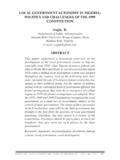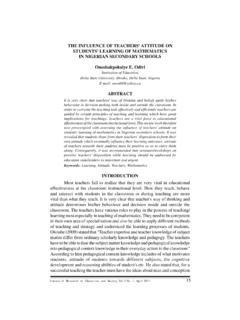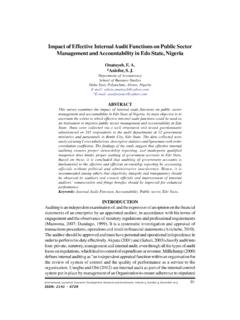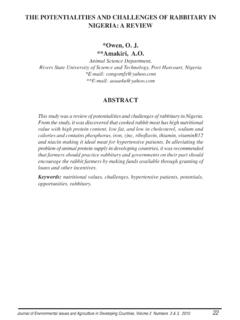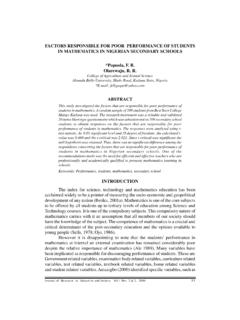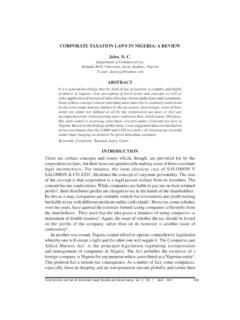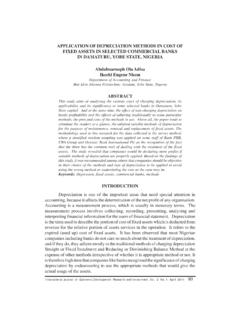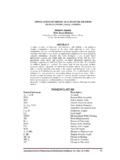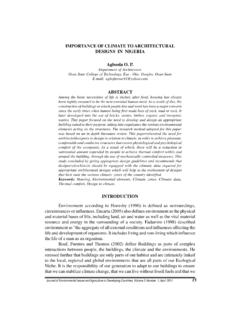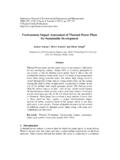Transcription of MAJOR FACTORS AFFECTING ELECTRICITY GENERATION ...
1 MAJOR FACTORS AFFECTING ELECTRICITY GENERATION , TRANSMISSION AND DISTRIBUTION IN NIGERIA. Sule, A. H. Department of Electrical Enginneering Hassan Usman Katsina Polytechnic, Katsina E-mail: ABSTRACT. ELECTRICITY GENERATION , transmission and distribution are three stages of delivering ELECTRICITY to consumers. The delivery of ELECTRICITY to consumers in Nigeria has multidimensional problems. This paper focused on capacity of ELECTRICITY GENERATION in Nigeria and the MAJOR FACTORS AFFECTING ELECTRICITY GENERATION , transmission and distribution in the country. The FACTORS are none diversification of sources of energy used in ELECTRICITY GENERATION , poor maintenance culture, electrical power transmission line losses due to long distance between generating stations and load centers etc.
2 Restructuring the Nigerian radial interconnected ELECTRICITY GENERATION station grid system which has National Control Centre atOshogbo and replace it with a regional interconnected grid system in order to reduce transmission line losses and improve reliability of the Nigerian grid system among others was recommended. Keywords: Power installed capacity, Transmission, Distribution, Megawatt (Mw), National Independent Power Projects (NIPP). INTRODUCTION. Electrical power GENERATION , transmission and distribution are the three stages of delivering ELECTRICITY to consumers at residential, industry, commercial, and administrative areas. The supply of adequate and stable ELECTRICITY to consumers is the back born of socioeconomic development of any nation.
3 While inadequate and unstable supply of ELECTRICITY to consumers in any nation would definitely lead that nation backward in terms its socio-economic growth. Like any other economic sector in Nigeria, the power sector has its peculiar problems. In fact the sector has multidimensional problems. This paper aims at discussing the MAJOR FACTORS AFFECTING ELECTRICITY GENERATION , transmission and distribution in Nigeria. For convenience the FACTORS are group into two, namely FACTORS AFFECTING ELECTRICITY GENERATION and FACTORS AFFECTING ELECTRICITY transmission and distribution. Some of these FACTORS are insecurity, overloading of distribution transformers, non-diversification of sources of energy (fuels) used to drive the ELECTRICITY generating stations, bribery, corruption and mismanagement of public funds in the execution and running of ELECTRICITY power projects.
4 The objective of this paper is to sensitize the Government, the governed and the organized private sector in order to solve the MAJOR problems AFFECTING ELECTRICITY delivery to Nigerian consumers. International Journal of Engineering and Mathematical Intelligence, Vol. 1 Nos. 1 & 3, 2010 159. ELECTRICITY GENERATION IN NIGERIA. The first ELECTRICITY generating plant in Nigeria was installed in Lagos in 1896. The Plants were installed at isolated units owned and operated by either Native Authorities as in Ibadan and Kano, or by the public works departments as in Warri and Port-Harcourt. The isolated units were merged together when Nigerian Colonial Government passed the ordinance of 1950 which set up the ELECTRICITY Corporation of Nigeria (Uwaifo, 1994).
5 The Corporation and the Niger dams Authority set up by an Act of Parliament in 1962 to exploit the water resources of the River Niger were unified into the National Electric Power Authority in 1973 through the Federal Military Government Decree No. 24 of June 27, 1972 (Uwaifo, 1994). The first ELECTRICITY generating plant to be commissioned in Nigeria was Ijora 'B' Power station (Lagos) in 1956 by the head of British Common Wealth and the Queen Elizabeth. A grid power transmission system that evolved connecting large power stations in Kainji, Jebba, Shiroro, Afam, Delta (Ughelli), Sapele (Ogorode) and Egbin (Lagos). came into being in the first half of the 1960s. That grid system served every state capital in Nigeria. By 1992, the total installed GENERATION plant capacity was about 5,900 Mw.
6 The total ELECTRICITY available was 3,000 Mw and the coincident maximum demand had reached 2,400Mw (Uwaifo, 1994). In 2009, the ELECTRICITY generating station installed capacity in Nigeria was 5000Mw, but only 2900Mw was generated as at November, 2009 (Babalola, 2009). ELECTRICITY can be generated at Hydro, Thermal, Wind, and Solar generating stations. ELECTRICITY is generated at thermal generating stations where fossil fuels such as crude oil, natural gas, coal are burnt to produce high pressure (typically 2400 to 3500/1b/in2) and high temperature (1000oF). steam, which is used to drive turbines at 3600 rev/min which in turn drive electrical generators to produce ELECTRICITY (Donald, Beaty, Miley and Clapp, 2000). The concentrated solar power generating stations use mirrors or lenses to concentrate sunlight into a relatively small area and then use the resulting heat to raise steam to drive steam turbines and generators to produce Alternative Current (AC) power.
7 There are two methods of generating ELECTRICITY namely; conventional method and non conventional method. The conventional method makes use of prime movers such as petrol engine, diesel engine, steam turbine, while non conventional method do not use prime movers. This includes Magneto Hydro Dynamic (MHD) generators, solar cells, fuel cells, wind, thermoelectric generators etc. Most of ELECTRICITY generators are three phase-ac generators known as synchronous generators or alternators. They use rotating rectifiers called brushless excitation systems to maintain the generator voltage and control the reactive power flow at 30KV, 50Mw to 1500. Mw capacities (Hadi, 2004). The availability of natural fuels such as coal, crude oil, natural gas of 180. trillion cubic feet(Amotsuka, 2008) and Rivers in Nigeria lead it to utilize hydro plants and steam gas turbines for ELECTRICITY GENERATION at Afam, Delta, Egbin, Sapele, International Journal of Engineering and Mathematical Intelligence, Vol.
8 1 Nos. 1 & 3, 2010 160. Kainji, Shiroro, Jebba and the proposed Monbila ELECTRICITY generating stations. Another source of fuel for generating ELECTRICITY at very small scale in Nigeria is Uraninium use at National Nuclear Research Centre Zaria. CAPACITY OF ELECTRICITY GENERATION STATIONS IN NIGERIA. Nigeria uses three types of ELECTRICITY GENERATION stations namely Hydro- generating stations, Steam turbine generating stations and gas turbine generating stations. Table 1 shown below gives the locations and the ratings of ELECTRICITY generating stations use in Nigeria. Table 1: ELECTRICITY generating stations, ratings and their locations in Nigeria Station Type No. of Units Installed Capacity KVout MWout Kainji Hydro 8 760. Afam I-III Gas Turbine 12 260.
9 Afam IV Gas Turbine 6 450. Afam V Gas Turbine 5 760. Egbin Steam Turbine 6 1320. Egbin Gas Turbine 9 270. Jebba Hydro 6 570. Sapele Steam Turbine 6 720. Sapele Gas Turbine 4 300. Shiroro Hydro 4 400. Delta II Gas Turbine 6 120. Delta III Gas Turbine 6 120. Delta IV Gas Turbine 6 600. Source: (Nigeria Society of Engineers Technical Transactions, 2007, Vol. 42, No. 1, p27). In Nigeria the ELECTRICITY generating stations are interconnected in radial form with a single National Control Centre (NCC) in Oshogbo. This has lead to low reliability index of the Nigerian National grid (Yusuf, Boyi and Muazu, 2007). The Nigerian government has awarded contract for GENERATION , transmission and distribution of 6000Mw with completion date on December 2010. This seem impossible, if you look at electric power score card of the government that is the installed capacity of ELECTRICITY generating stations in Nigeria is 5000Mw, but only 2,900 Mw is generated as at November, 2009 due to MAJOR FACTORS AFFECTING ELECTRICITY GENERATION , transmission and distribution in Nigeria to be mention in this paper.
10 MAJOR FACTORS AFFECTING ELECTRICITY GENERATION , TRANSMISSION AND DISTRIBUTION IN NIGERIA. There are many FACTORS that affect ELECTRICITY GENERATION in Nigeria, the MAJOR ones include but not limited to: (i) The Niger Delta crisis which leads to the vandalization of oil and gas pipe lines, oil gas exploration and exploitation facilities. (ii) The kidnapping of foreign and indigeneous professionals that manned oil and gas facilities in Nigeria resulting into abandoning of oil and gas exploration. (iii) The inability of Nigeria government in collaboration with oil multinational International Journal of Engineering and Mathematical Intelligence, Vol. 1 Nos. 1 & 3, 2010 161. companies to utilize fully the gas, due to gas flaring. The gas is a good source of energy for the GENERATION of ELECTRICITY (iv) Low level of annual rainfall in Nigeria due to global warming which leads to global climate change that affects water level at hydro GENERATION stations.
